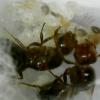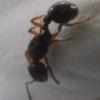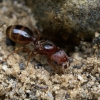- Formiculture.com
- Forums
- Gallery
- Members
- Member Map
- Chat

Solenopsis Molesta Queens and cohabitation
Started By
Works4TheGood
, Aug 3 2015 7:23 PM
solenopsis molesta
22 replies to this topic
#1
 Offline
-
Posted August 3 2015 - 7:23 PM
Offline
-
Posted August 3 2015 - 7:23 PM
Hi all,
I have 3 solenopsis molesta queens in test tube setups right now. However, I just read that these guys can have several queens. If I want these three queens to all be in a single colony, do I need to put them all in the same test tube ASAP, or can I wait until I can open their test tubes up together in an outworld? Also, by adding more queens, am I increasing the maximum potential size of the colony? How does cohabitation such as this play out in nature?
I have 3 solenopsis molesta queens in test tube setups right now. However, I just read that these guys can have several queens. If I want these three queens to all be in a single colony, do I need to put them all in the same test tube ASAP, or can I wait until I can open their test tubes up together in an outworld? Also, by adding more queens, am I increasing the maximum potential size of the colony? How does cohabitation such as this play out in nature?
~Dan
#2
 Offline
-
Posted August 3 2015 - 7:48 PM
Offline
-
Posted August 3 2015 - 7:48 PM
If they're like S. invicta, they're polygynous at the founding stage. If you put them together after they start having workers there's a very good chance they will be hostile to each other. But they might decide to choose one queen over the others and kill the two rejects as well if you raise them all together. I can't say for sure about S. molesta, but that's usually how S. invicta opperates.
#3
 Offline
-
Posted August 3 2015 - 7:54 PM
Offline
-
Posted August 3 2015 - 7:54 PM
I'm pretty sure S. molesta is highly polygynous and large colonies may produce queens at a constant rate and re accepting queen, I'm no expert (especially with Solenopsis) but I think they'll make it. I would suggest (since you have 3) put 2 in a tube and one by herself if you whant.
- Jonathan21700 likes this
#4
 Offline
-
Posted August 3 2015 - 8:25 PM
Offline
-
Posted August 3 2015 - 8:25 PM
As long as they don't have workers, the queens SHOULD be able to live together for life, without harming each other. If you do have workers, I'm not sure if it works the same, but it might.
- LC3 likes this
#5
 Offline
-
Posted August 4 2015 - 11:59 AM
Offline
-
Posted August 4 2015 - 11:59 AM
Before I had S. fugax (similar to molesta) and I put two queens together in a dirt nest. They started digging together, after half an hour and finished their chamber over night. Everything was fine they laid a big pile of eggs and in one month got larvae. The larvae were almost ready to pupate when I found one queen dead and the other badly injured. So I recommend if you only have 3 queens to put them in separate setups or put two together and leave one by herself. Good luck!
#6
 Offline
-
Posted August 4 2015 - 1:23 PM
Offline
-
Posted August 4 2015 - 1:23 PM
I definitely know that my tube with two queens of S. invicta was very successful compared to my other queens, so you can try to raise them together and split them up when they've got pupae or nanitics. But make sure if you do split them you don't injure or stress out either queen in the process. I definitely did a terrible job on this part and both of them lost most of their brood and the other died after I seriously did a terrible job trying to split them DX
#7
 Offline
-
Posted August 4 2015 - 5:56 PM
Offline
-
Posted August 4 2015 - 5:56 PM
So are there any advantages to having multiple queens in the colony? Does the colony grow faster or reach larger sizes?
~Dan
#8
 Offline
-
Posted August 4 2015 - 6:18 PM
Offline
-
Posted August 4 2015 - 6:18 PM
Main advantage is that the colony would grow faster. Like I said I'm not to good with fire ants so I dunno too much about their biology.
#9
 Offline
-
Posted August 4 2015 - 6:44 PM
Offline
-
Posted August 4 2015 - 6:44 PM
It grows faster, but it has diminishing returns. A colony with two queens will not grow twice as fast, but it will grow faster than a founding colony with one. Out of all my S. invicta only one was fruitful of my single queens, and the only doubled up tube I made was healthier than that.
- drtrmiller likes this
#10
 Offline
-
Posted August 4 2015 - 8:02 PM
Offline
-
Posted August 4 2015 - 8:02 PM
So I went out to my garage to combine two of my solenopsis molesta queens, when I discovered that most of the queens I'd collected over the past two weeks were dead inside of their test tube setups. Some of them may have been a parasitic lasius species (how long can they live without a host?), but also one of my solenopsis molesta queens died too, as well as an unknown other queen, which could have been a male. I'm feeling pretty discouraged right now. I wonder if my garage is getting too hot for them. I can't put them indoors since my wife wants every room air conditioned. In my frustration, I combined the two remaining solenopsis molesta queens - one of which had already laid 3 itty bitty eggs. I figured that since they'd probably both die anyway, oh well ... sigh
~Dan
#11
 Offline
-
Posted August 4 2015 - 8:15 PM
Offline
-
Posted August 4 2015 - 8:15 PM
I wonder if my garage is getting too hot for them. I can't put them indoors since my wife wants every room air conditioned.
They should be kept between 80 and 85 F.
A garage with peak temperatures in the 90s will be harmful, and lower temperatures will inhibit brood growth.
- BrittonLS likes this
byFormica® is the manufacturer of the iconic nectar feeders and Sunburst Ant Nectar.
byFormica ant products always deliver consistent performance, convenience,
and reliability, making them among the most beloved ant foods and kit enjoyed by
ant keeping enthusiasts worldwide. For more information, visit www.byFormica.com.
#12
 Offline
-
Posted August 4 2015 - 9:33 PM
Offline
-
Posted August 4 2015 - 9:33 PM
Try to find a place in your house that doesn't get much ventilation, I'm sure you know a place where it always seems to be too hot in your house where it seems like the ac isn't high enough? For myself I have a shoebox in such a room with a 15 W heating cable going into it that keeps it around 80 degrees in there. I also bought a tiny little thermometer when I was at the hardware store. Careful if you're using plastic test tubes or the like, don't set them on the heating cable. It will be too hot -sigh- lol Glass ones are ok I think though from what I've seen other people do.
#13
 Offline
-
Posted August 5 2015 - 6:15 AM
Offline
-
Posted August 5 2015 - 6:15 AM
The advantage to having multiple queens, is you have about the same probability of ending up with a successful colony as you would dividing them all up, but you would only have the work of maintaining a single enclosure.
#14
 Offline
-
Posted August 5 2015 - 6:30 AM
Offline
-
Posted August 5 2015 - 6:30 AM
If you split them up after nanitics, how likely is it that each individual queen still continue to succeed? Has there been any studies of whether all the queens in a polygynous founding setup lay eggs or if it's only one doing the work?
Camponotus vicinus, Crematogaster 1, Crematogaster 2, Formica francoeuri, *, *, Myrmecocystus testaceus, Novomessor cockerelli, Pheidole hyatti, Pogonomyrmex californicus, Pogonomyrmex rugosus, Solenopsis invicta
#15
 Offline
-
Posted August 5 2015 - 6:44 AM
Offline
-
Posted August 5 2015 - 6:44 AM
Regardless of whether they're together or separate, some queens lay eggs, and some don't. I haven't heard any reason that a polygynous situation would make a queen not lay eggs that otherwise would.
#16
 Offline
-
Posted August 5 2015 - 9:45 AM
Offline
-
Posted August 5 2015 - 9:45 AM
Regardless of whether they're together or separate, some queens lay eggs, and some don't. I haven't heard any reason that a polygynous situation would make a queen not lay eggs that otherwise would.
I have, I remember hearing that some queens who start their stages of colony founding with other queens sometimes lay less eggs so they don't end up loosing the "election" ...Not sure how it works though.
P.S The workers are smart and the selfish queens usually end up ded.
#17
 Offline
-
Posted August 5 2015 - 1:31 PM
Offline
-
Posted August 5 2015 - 1:31 PM
I guess the point of my question is, what do you guys plan to do with your polygynous colonies? Just let them be and if the workers decide to kill off the other queens then so be it? Or eventually try to separate them?
Camponotus vicinus, Crematogaster 1, Crematogaster 2, Formica francoeuri, *, *, Myrmecocystus testaceus, Novomessor cockerelli, Pheidole hyatti, Pogonomyrmex californicus, Pogonomyrmex rugosus, Solenopsis invicta
#18
 Offline
-
Posted August 5 2015 - 2:12 PM
Offline
-
Posted August 5 2015 - 2:12 PM
I plan to keep mine together. I see no point in maintaining multiple enclosures and doing multiple feedings for the same species.
#19
 Offline
-
Posted August 5 2015 - 3:24 PM
Offline
-
Posted August 5 2015 - 3:24 PM
I plan to keep mine together. I see no point in maintaining multiple enclosures and doing multiple feedings for the same species.
Ah, the advantage I like of having multiple colonies is more to trade/sell/give. But no point if the separated queens do not lay any more eggs.
Camponotus vicinus, Crematogaster 1, Crematogaster 2, Formica francoeuri, *, *, Myrmecocystus testaceus, Novomessor cockerelli, Pheidole hyatti, Pogonomyrmex californicus, Pogonomyrmex rugosus, Solenopsis invicta
#20
 Offline
-
Posted August 5 2015 - 5:10 PM
Offline
-
Posted August 5 2015 - 5:10 PM
Oh yeah if I planned to sell or trade, then yes, I would separate them.
Also tagged with one or more of these keywords: solenopsis molesta
2 user(s) are reading this topic
0 members, 2 guests, 0 anonymous users

























